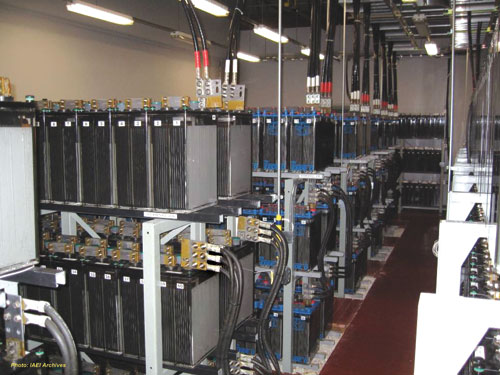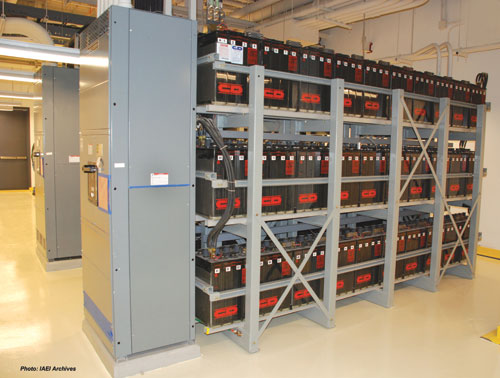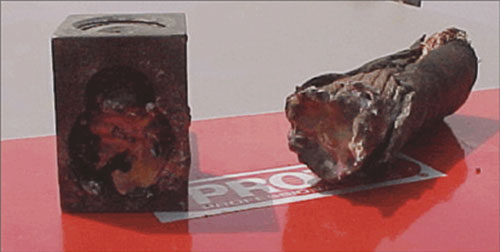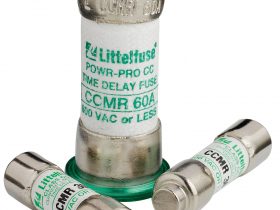Dangerous conditions exist in battery rooms all over the country, but the batteries themselves are not a hazard. The hazards come from working conditions that are often unsafe because of limited paths of egress or escape, poor lighting, no working clearances, no guards for exposed live parts, and little or no ventilation. It is often difficult for the electrical worker to de-energize the battery system for maintenance, repair, or replacement of equipment. Even when disconnected from the rest of the bank, individual batteries remain energized; however, when connected to the bank, voltages may be high, and amperages even higher, which means considerable stored electrical power is present. Grounded concrete or cement surfaces often surround the battery bank, increasing the danger of the workspace. Is the worker even aware of the safety risk?
This article will discuss how these potentially serious safety concerns can be lessened.

Photo 1
Batteries are used for emergency, legally required, optional power, fire alarm, security, telecommunications, smoke alarms, and photovoltaic systems, along with many other electrical uses. For instance, Section 700.12(A) permits storage batteries to be a source of emergency power if they have suitable capacity and can carry the load for a minimum of 1.5 hours, and can maintain the voltage of the system at acceptable levels. Section 700.4 covers emergency power systems testing, and requires witness testing, periodic testing, testing under load, and maintenance. Written maintenance records are to be kept on file. If storage batteries are utilized as part of an emergency power system, these requirements apply.
Scope
The scope ofNEC480 “applies to all stationary installations of storage batteries,” which is significant, and many electrical professionals may not realize this fact. The wiring and equipment supplied by storage batteries is subject to the same applicable provisions of this Code as other equipment that operates at the same voltage (480.3). The working clearance requirements in Section 110.26 apply, for example, but so do the requirements found in Sections 110.11, 110.12, 110.13, 110.14, 110.16, 110.18, 110.22, 110.26, and 110.27, just to name a few.
Overcurrent Protection

Photo 2. Battery bank with disconnect and overcurrent protection
Storage batteries—with the exception of those that are rated at 50 volts that are used for starting, igniting, or controlling prime movers, such as electrical generators, for example—require overcurrent protection. The point here is that most storage battery installations require overcurrent protection. The question is, does a fuse or circuit breaker protect the battery conductors from overcurrent in the installations that you work on? Frequently, when you investigate you may find there is no overcurrent protection present or provision for it in the installation, even though the Code began requiring overcurrent protection in the 2002 edition. The requirements are there for good reason. Current can be very high in storage battery systems, and may introduce serious hazards to those that work on or around the equipment. Care and thought must be always be exercised before working on or around any storage battery system.
Disconnecting Means
In NEC-2008, new requirements have been added for disconnecting means of all ungrounded conductors derived from a stationary battery system that is rated at over 30 volts (see ROC 13-21). The disconnecting means is required to be readily accessible, and to be located within sight of the battery system. Within sight as defined in Article 100 is “visible and not more than 15 m (50 ft) distant from.” This new requirement came as the result of the need for qualified persons to disconnect safely electrical power to battery systems for maintenance. Having a localized disconnecting means helps maintenance to be performed in a safer manner.
The disconnecting means is not required to have a locking means that remains in place as part of the equipment, though it would be helpful to safety. OSHA rules require lock-out and tag-out procedures, which are in addition to but not included in the NEC.
Storage batteries in operation may be supplying power to loads or recharging. In other words, they may be supplying power to a load or receiving power via a battery charging system of some sort; or they may be connected to an uninterruptible power supply system, for example. At least two safety concerns must be considered here if work on the system is required while the system is being energized: (1) the disconnection or removal/replacement of batteries using wrenches or other hand tools, and (2) the presence of hydrogen or other gases. Therefore, qualified persons must follow safe work practices, wear proper personal protective equipment (PPE), make use of all protective guards and rubber insulating mats available, and utilize tools that have the appropriate voltage insulation rating.
Terminations

Photo 3. Damaged wiring terminations, improper lugs used for fine stranded conductors.
NEC 110.14(A) requires a “thoroughly good connection without damaging the conductors.” The fine stranded conductors used and associated with storage battery systems require termination in a properly sized and rated lug. Standard off-the-shelf mechanical lugs intended for use with solid or the larger stranded conductors for building wire in electrical installations may cause loose connection problems to develop when they are used with fine stranded conductors.
Racks and Trays
Racks for storage batteries are required to be rigid and substantial and made of either (1) metal and that is covered with a corrosion-resistant material, or (2) nonconductive materials such as fiberglass. Trays are frames, such as crates or shallow boxes made of wood or other nonconductive materials, which are constructed or treated to resist deteriorating action by the electrolyte; trays are required (see 480.8).
Battery Locations
Battery spaces generally require ventilation and diffusion of gases to prevent an explosive mixture from accumulating. Live parts generally must be guarded from contact by persons; for instance, by a partition or partitions that are permanent, so that only qualified persons have access to the live parts. Any openings in the partitions must be sized and placed in a manner to protect persons and conductive objects from coming in contact with them.
Installations must comply with chapters 1 through 4 of the Code. Article 480 does not stand out as a “lone ranger.” Section 110.3(B) requires installers and maintenance personnel to comply with the requirements and directions included within the battery manufacturer’s instructions. NEC 110.12 requires that systems be installed in a workmanlike manner. Is this happening in the storage battery installations that you see, maintain, or inspect?
Are the Batteries the Sealed or Vented Type?

Photo 4. Damaged wiring terminations, improper lugs used for fine stranded conductors.
Each vented cell battery is required to have a flame arrester to prevent destruction of the cell due to an external spark or flame igniting gases that may be discharged from the cell under normal operating conditions. Sealed cell batteries are required to have a pressure-relief vent to prevent excess gas pressure from accumulating, or the cells must be designed to prevent cell parts from scattering in case of an explosion.
All manufacturers’ requirements must be read and followed by the end user of the product. For example, one UPS manufacturer had supplied on-line type UPS units for the 911-dispatch center of a small town of 26,000 population. The battery manufacturer stated in its literature that the sealed batteries would last 3–5 years. Exactly three years later, a majority of the batteries failed. What happened was that one cell in one battery would fail, the battery voltage would rise to 56-vdc across that cell, the voltage on the 48-volt dc system would rise, and the sealed battery would vent unpleasant gases into the building. The room was ventilated, but not nearly enough to address this unforeseen circumstance. Thereafter, the batteries were replaced just prior to the three-year deadline, and the room ventilation was increased.
Hydrogen gas can be explosive in heavy concentrations. Most storage battery locations would not be considered as classified, which would require compliance with Article 501. In most cases, installation of required ventilation in accordance with Section 480.9 would be sufficient. Classification of areas depends upon a number of factors — in this case, the quantity and type of batteries installed, the amount of hydrogen gas given off by the batteries, the size of the area or room, the design engineering, the manufacturer’s instructions, and the work or other activities taking place in the area.
Common Code Violations with Battery Systems
The primary goal of this article is to raise awareness of electrical safety in battery installations. The general requirements found in chapters 1 through 4 of the Code apply to storage battery installations. As one very important example stated earlier, many electrical professionals have not yet realized that the minimum safe working clearance requirements in 110.26 apply to all storage battery installations under jurisdiction of the NEC. Crowded battery rooms where the worker does not have safe working clearance to install, to add, to repair, or to maintain the equipment are common; and these situations may present a serious hazard to the worker. Exposed live parts and concrete or brick/cement block wall and/or floor surfaces are considered grounded surfaces that increase the possibility of electric shock [see 110.27, 480.9(B), and 110.26(A)(1) Condition 2 under Table 110.26]. Electrical workers must always be aware that even with the disconnecting means (switch) in the open position, an individual battery or group of batteries remain energized and can be hazardous to the work because of the stored electrical energy. Existing lighting and ventilation may be inadequate for installation or maintenance of the battery system without creating a hazard. Good illumination and ventilation are essential for safety [see 480.9(A) and (B)].
Installations are not planned to be unsafe. Yet unsafe conditions in battery installations exist for a number of reasons. Although the installation may have met minimum Code standards under an earlier edition, (1) the installation may have been added on to; or (2) the original designer may have meant well, but have been unaware of safety requirements; or (3) some emergency event, natural disaster, severe power outage, or other unforeseen event may have necessitated temporary measures for backup power from storage batteries; or (4) there were exposed live parts; or (5) these temporary measures were never intended to stay, or at least were never intended to end up this way. There may also be other reasons yet unmentioned. Let’s face it, unsafe situations are often inherited from previous owners, installers, or management groups, and left for others to deal with. Regardless of how the situation occurred, with a little effort and initiative, worker and building safety can be improved.
Making Corrections/Improvements
What can be done to improve an unsafe condition in an existing storage battery installation? When considering making corrections to existing installations, you should evaluate each installation individually on its own merit. When the installation occurred and under which edition of the electrical code it was made should be determined. Input from the local AHJ could prove to be helpful in determining which corrections, if any, will be required. Hopefully, the AHJ is reasonable and will assist you by answering your questions and by dealing with existing conditions that are less than code-perfect.
The optimum may be a completely new battery room or a remodeled location. If a new battery room is an option, great! Often, however, one must do the best that one can to improve an existing installation and to make it safer. Ungrounded surfaces, such as plywood or gypsum wallboard, attached over existing concrete or otherwise grounded walls, for example, can remove the grounded surface from a Condition 2 workspace and improve worker safety (see Table 110.26). (Fire resistance ratings of building surfaces must also be considered when taking this approach, but if done right, there is an immediate possibility of improved worker safety). Where Table 110.26 Condition 3 workspaces exist, they could possibly be improved by installing insulated material or by better guarding of live parts.
Installing better illumination that is rated for the environment and providing or improving ventilation will help. Some workplaces have experienced lost time and worker complaints of breathing air contaminated by the venting of “sealed” batteries when unexpected problems arose or when maintenance guidelines were not followed.
Improving the rack or tray system, guarding live parts, installing overcurrent protection and a disconnecting means within sight of the installation all would improve worker safety. Identifying voltages, systems, and disconnecting means to disconnect the power, as well as identifying all storage battery systems if more than one exists in the same location, could also improve safety.
There may be other Code requirements such as those in mechanical and structural codes that are also applicable to this type of installation. In many cases, the NEC is not the only set of rules that would be applicable.
In this article, we have briefly discussed storage battery installations per NEC-2008, overcurrent protection, disconnecting means, terminations, racks and trays, battery locations, sealed or vented type batteries, common Code violations, and making corrections/improvements. The hope is that awareness of Code requirements and the possible hazards present in these types of installations has been raised, with the goal of seeing new installations installed in a manner that will promote worker safety, while providing some direction toward improving existing installations.














Find Us on Socials